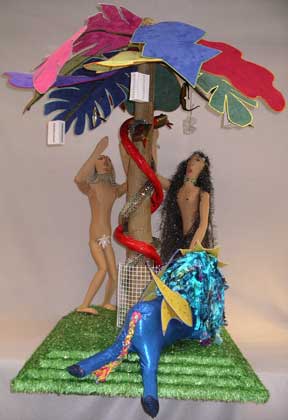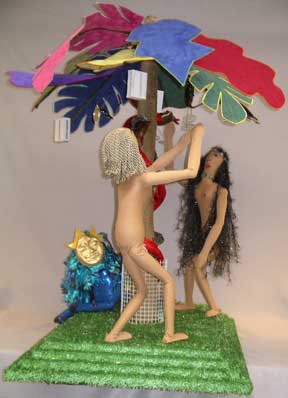FiberAlchemy.com
Adam and Eve in the Garden of Eden
Construction is 3’ x 2’ at the lowest level of the base. Tree is 41” tall. Adam and Eve are 26” high. The cherub is 15” from nose to tail.
Materials and techniques: Particleboard base is covered with green and metallic fabric. The Tree of Knowledge is wire mesh, wrapped with batting and then covered with fabric. Leaves are sueded microfiber with heavy iron-on Pellon™ sandwiched between, and then satin-stitched. Each leaf has a green silk wired stem. Hanging from the tree are doll-sized eyeglasses and sunglasses; handmade boxes with “Knowledge,” “Duality,” “Categories,” Discernment,” and “Judgment” written on them; a wristwatch that has “Time” written on the face; and a doll-sized mirror.
Snakes are stuffed bronze-colored snakeskin vinyl with red, heart-shaped beads for eyes and felt, forked tongues. Each has a shed-able overskin of glittery Lycra. The picket fence is metal mesh, spray-painted white.
The cherub’s skin is blue metallic Lycra; his wings are yellow metallic lycra, stiffened with Pellon™ and decorated with Swarovski™ crystals; his hair and tail are yarn; his face is handmade from Paperclay,™ painted gold.
Adam and Eve are adjustable wood artist manikins covered with fabric “skin.” Both figures have bead nipples, and their genitals are hidden beneath beaded, sequined fig leafs. Eve’s hair is yarn; an embroidered-leaf ribbon adorns her neck and a floral ribbon serves as her headband. Adam’s hair and beard are upholstery trim.
The image of Adam and Eve, the Tree, and two snakes came to me during meditation on Genesis 3.1-3.24. I also imagined including four rivers flowing out from under the Tree of Knowledge (as described in Genesis), and the Garden surrounded with twelve gates (“There’s twelve gates to the City, Halleluiah….”). I saw a winged cherub watching patiently for Adam and Eve to pluck from the tree and get kicked out of the Garden.
As the piece developed it became obvious that twelve gates and four rivers simply would not fit—they would distract from the central images. I kept returning to various versions of the text to discern what needed to be shown. In Genesis, the serpent, shrewdest of all wild beasts, tells “the woman” (later known as Eve) that she will not die if they eat the fruit of the tree—rather, “your eyes will be opened and you will be like divine beings who know good and bad.” The woman “saw that the tree was good for eating and a delight to the eyes, and the tree was desirable to contemplate.” She took the fruit and gave some to her husband. Jewish tradition postulates that the fruit was wheat, grape, fig, or citron, produce found in the Near East, but in Christian tradition the fruit is generally described as an apple, a popular European fruit. The Latin translation of the Hebrew word for “bad” is malum, which means apple. Hence the misapprehension that the fruit of the Tree of Knowledge was an apple.
As I pondered the image, I realized that the “fruit” of the tree was something else entirely: the ability to make distinctions, judgment, choices—to see the world in terms of duality and categories. In my version, both Adam and Eve reach for the fruits of the tree. I prefer not to maintain the idea that Eve was to blame for tempting Adam; instead of Adam being passive, he is as active as Eve. Perhaps the real “original” sin was Adam’s failure to take responsibility for his own actions. In my recreation of the Garden, they are both equally active.
Adam and Eve lost their innocent non-judgmental awareness of Being when they took from the tree and entered into a world of Doing and awareness of sexuality. And it was by so doing that human procreation began—and that humans learned moral discrimination and intellectual judgment, and began living life with the knowledge of death and of good and evil. Hence the mirror of self reflection, the glasses of discernment with various colored lenses, the watch with “Time” on its face, and the labeled boxes of various kinds that dangle from the alluring tree that is “a delight to the eyes.”
There are two serpents in this Garden. Although serpents have often been given a bad rap in Near Eastern mythology, the medical caduceus symbol is made up of two intertwined serpents—clearly suggesting that serpents have some beneficial associations as well. After all, we have the expression, “wise as serpents”—and serpents also represent subterranean Earth energies (the woiuvre) and ancient Earth- and Goddess-centered religions. I decided to acknowledge these aspects of the serpents and have two of them twining around the Tree of Knowledge. They also represent DNA and Kundalini energy. They have extra skins that they can shed, thus linking them to immortality as well as wisdom.
As to the cherub: G-d posted cherubim (in one text, called “winged sphinxes”) and an everturning, flaming sword outside the east entrance to Eden to keep Adam and Eve from returning and going to the Tree of Life (knowledge and immortality would have made them truly G-d-like!). Sources differ on the appearance of the cherubim, but they were not the cute winged baby faces (“cherubs”) that become popular during the Renaissance. The cherubim apparently had four wings and were composite beasts, perhaps a combination of ox, eagle, lion, and human—the same symbols that represent the Four Apostles—symbols that also represent the four elements. Although I was tempted to include it, I left off the flaming sword. Too distracting.
Time is conflated in this Garden: Adam and Eve are reaching for the “fruits” of the Tree of Knowledge, but they already have fig leafs covering their genitals, as if they already knew they were naked. And a cherub is watching, even though the cherubim do not appear until later. Perhaps the story never ended….. Perhaps it continues to happen…..

